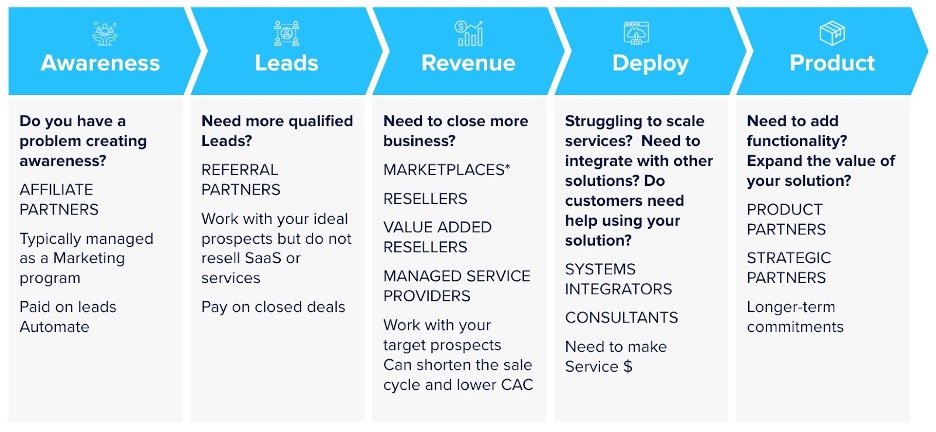Partnerships have always been a popular way for companies to expand their reach, capabilities, and customer base. However, successful partnership programs require careful planning, execution, and ongoing monitoring – you really want to know how to do it right before investing time and effort in partnerships. Here’s a partnership-building roadmap that also illustrates some potholes to avoid along the way.
Should You Partner?
One of the first things to evaluate when considering partnering as an early-stage SaaS company is the overall strength of your go-to-market strategy, specifically how you market, sell, and deploy your solution. If you’re presently unable to do that at scale, then relying on partners won’t work. Partners engage with companies that understand and can teach them how to market, sell, and deploy their solutions. So before going down this road and recruiting partners or responding to inbound inquiries, ask yourself: “Can you can afford the time and energy it takes to manage a partnership? Are you ready and do you truly appreciate the effort that it takes?”
Here’s a simple checklist to help you assess if you’re ready:
You’ve established product-market fit with repeatable sales and renewals
Your GTM operations and processes are already scaling
You’re starting to see inbound partner inquiries
You understand how to attract/recruit/close/ramp/co-sell with partners
You have prioritized any product modifications needed to support partners
What types of partners should you work with?
When it comes to partners, there are different objectives and types of partnerships that companies can pursue, each with its own unique benefits and challenges. Choose your partners carefully to align with the specific strategy you want to engage at this point in your growth.
Awareness: Build your brand and authority with Affiliate Partners through thought leadership to drive traffic and awareness.
Leads: Increase your reach and drive top-of-funnel lead gen through joint marketing programs and regional events with Referral Partners. All business is transacted by you and not the partner.
Revenue: Drive indirect revenue contracted through a partner, increasing reach and reducing both sales cycle time and customer acquisition costs. There are many different types of partners at this stage – Marketplaces, Value-Added Resellers, Distributors and Managed Service Providers (MSPs). You will need to understand how each different type of partner works to optimize for each.
Deployment: Achieve scaled implementation and deployment capabilities that augment your product through partners. Systems Integrator (SI) and Consulting partners can be critical when it comes to complex deployments that require integration with other enterprise software and would otherwise consume your precious few resources.
Whole Product: Partners can readily complement and round out your offering either through their own software assets or service packages that they create around your product for specific use cases or industries. This can work both ways, where you may want to resell a partner’s complimentary offering as part of a bundled solution.
Make sure you understand how your partners align with your overall go-to-market strategy and that you set the right expectations of their impact so that you invest the right effort to make them successful. If you don’t have alignment or mutually agreed upon goals, then chances are your partnerships will fail.
Potholes to Avoid
One of the most common mistakes that companies make when it comes to partnering is trying to do too much too quickly. Companies that rush into partnerships without fully understanding their goals or the requirements of their partners are likely to encounter problems down the road. Here are some of the most common potholes to avoid:
Investing Too Early in Partnerships: Wait until you have achieved go-to-market fit with scalable sales and customer success motions. Beware of OEM deals that appear lucrative at this stage, but can dilute your brand value and lock you out of key potential markets.
No Joint Value Prop: Make sure you understand not only your value proposition but the value prop of the partnership for both your partner and the end customer. You have to be able to explicitly communicate what the partner has to gain by working together. Remember, it’s not just about the money.
Spray and Pray: Don’t engage with too many partners out of the gate. Wait for inbound inquiries. That will be a strong indication of market fit and demand. Begin by only signing a few partners and then document and optimize what makes them successful (or not) before building a partner program. Create a strategy and know what it takes to succeed.
Lack of Resources: You have to work with partners to help them understand how to use your product, how to support it, how to sell it, how to market it, and how to work with your sales team. Success requires dedicated and accountable resources. Don’t simply assign a sales or marketing person to focus on partners on a part-time basis. They must be dedicated and compensation plans across the direct and indirect channels must be aligned.
Believing Press Releases: There is little value in just doing a partnership press release. We only celebrate when we drive sustainable revenue. Your business needs to continuously grow and so does your partner revenue before you attach too much meaning to the joint efforts.
Aligning Resources to the Partner Lifecycle
We’ve established that it takes work to attract, qualify, close, and then properly engage with partners. The work is not done when the agreement is signed. You have to anticipate what it takes to succeed and resource the team properly.
It’s not enough to assign responsibility for partnering to the Sales organization. To succeed, you need a dedicated FTE with proper direction and goals. Initially that person will be responsible for all aspects of the partnership lifecycle, from inception (responding to inbound leads and prospecting) through training and ramping and then quarterbacking as partners work with the sales team to close initial deals.
Once you have defined and optimized the partnership lifecycle, then as volume scales you can specialize with individuals or teams focused on specific functions such as ramping and managing partners. Later you will probably specialize around the types of partnerships and their location.
I’m often asked to come in and assess why a client’s partners aren’t performing to expectations. Successful partnerships requires careful planning, execution and ongoing engagement. They can accelerate your revenue and reach, but only when you’ve done the fundamental work to acquire and deploy customers at scale yourself. Companies that take the time to assess their readiness for partnering, develop a strong joint value proposition and carefully vet potential partners are more likely to achieve positive outcomes from their partnerships.












